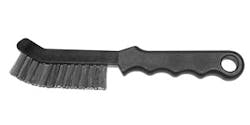Basics of Brake Service Equipment
BRAKE LATHES
When purchasing and using on-car brake lathes, shops benefit most from lathes that are "fast to use, and not too complicated,"according Geoff Womer, product manager at Pro-Cut International. This philosophy has manufacturers constantly advancing their designs. "It's all about speed and simplicity,"said Womer.
"What's critical to brake service is that the rotors are matched to the hub when you're finished … you can't get that with a bench lathe,"Womer said. Added efficiency comes as "computer and mechanical alignment equipment basically take the on-car lathe and, with the push of a button, perfectly align it so the machined rotor will be perfectly aligned, too,"said Womer.
A computer-generated reports feature
can keep shops up-to-date on ROI and the status of a machine.
"The odometer-type reading is basically delivering a productivity report on how much
money the lathe is making you, or not,"said Womer. "It's also diagnosing
itself so it will be able to tell the end-user…whether or not it's in good health."The
reports also provide live lateral run-out readings so techs can verify accuracy.
Most on-car brake lathes will run from $6,000 to $12,000, depending more on the types of vehicles they work on than included features — and setup and training is typically included.
BLEEDERS/FLUSHERS
Technology for brake bleeders and flushing systems is evolving, according to Andy Wasielewski, division manager at Vacula. He added that equipment and procedures as little as 2-3 years old are already outdated.
"With hybrid vehicles on the horizon, as well as different forms of antilock and computerized braking systems, there are different specifications now,"Wasielewski said. "Even in regards to whether it's OK to vacuum bleed or pressure bleed."
He said that modern cars require case-by-case bleeding, making it essential that shops pick a machine capable of handling the various models their shop services. Key points to consider include if the machine bleeds or flushes (or does both), and if it works through pressurizing the system or a vacuum. (And if it's pressure, can you regulate the pressure?)
Some newer cars have their own bleed sequences, and more brake bleeders are being built based on OE specifications to better accommodate specific needs. Some bleeders now include an optional adapter to bleed clutch cylinders on standard transmissions in addition to performing the routine procedure.
Prices on these machines will vary, said Marc Pagliuca, director of business development at Motorvac, but buyers can usually count on vacuum brake bleeders to average $300, and flushing machines $3,500. Pressurized systems will generally run between $2,000 and $2,500.
